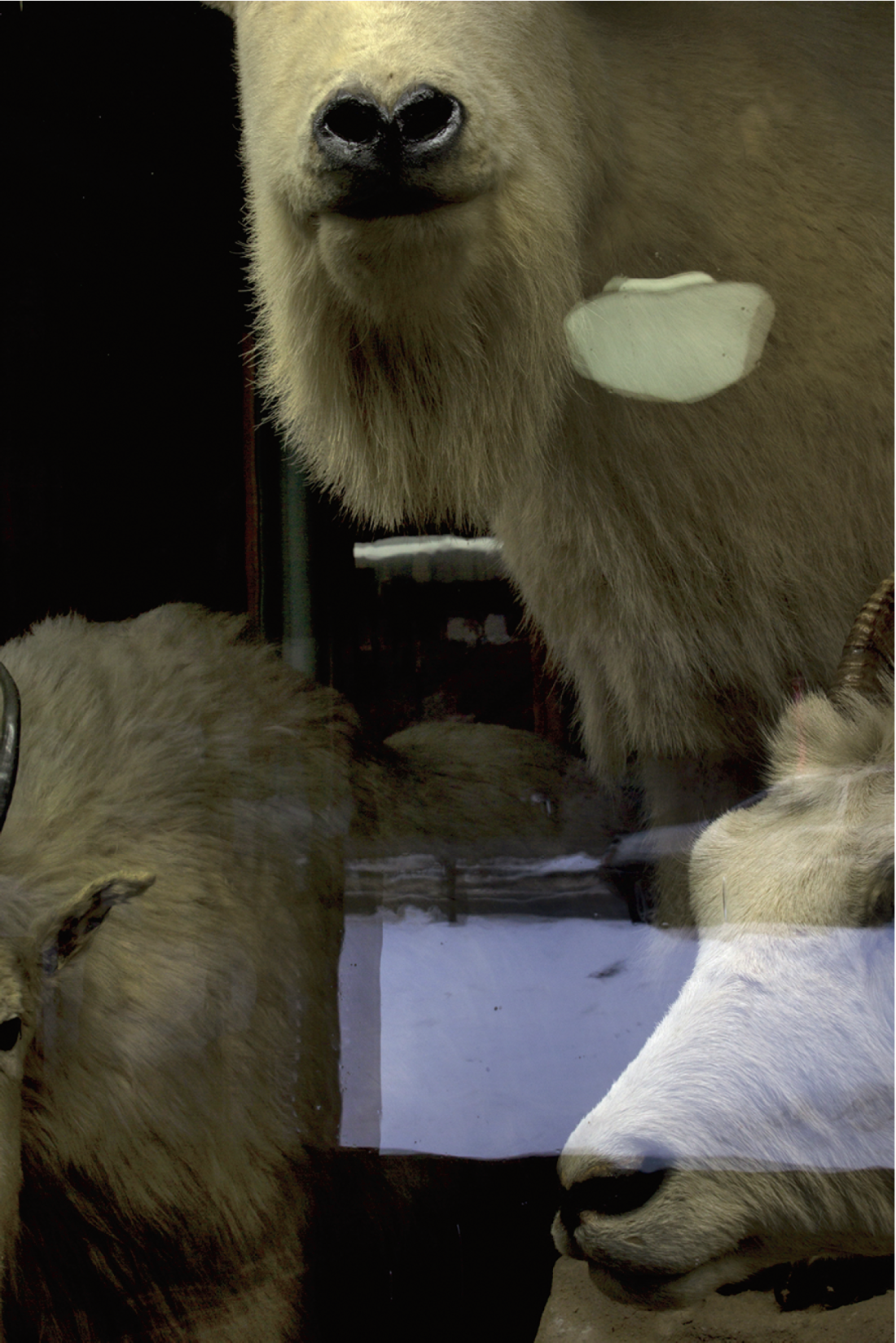Brad Isaacs
Taxonomies used in both scientific and museological contexts are a motif in Brad Isaacs’s photographic practice. His work becomes a system of classification that offers distinct views of animal bodies, usually after death. Some works present the abject, while others depict the sterilized bodies of lifeless specimens for study, or taxidermied for viewers’ edification and artificial experience of nature. The works exhibited at two galleries in Hamilton present a critique of the increasing distance between animals and humans, one that is influenced by a hierarchy often imposed by Western ideologies.
Several of Isaacs’s images capture the abject in cropped compositions that allow for an uncomfortable intimacy with the dead creatures. Beyond representing systems of classification, the works also signal a pervasive desire to control nature and wildlife. To create several works, Isaacs ventured into museums to capture sterile, prepared animals housed in dioramas that are ostensibly for the viewer’s benefit. These photographs are contrasted with behind-the-scenes images taken in refrigerated storage units that preserve skins and furs for researchers, and more unsettling, with carcasses in the garbage.
Isaacs cites Hiroshi Sugimoto’s diorama photographs as an influence. However, Sugimoto used the camera to create black and white photographs that make the scenes look like nature photography. In contrast, Isaacs’s images contain clues as to the animals’ actual artificial setting. These contextual signifiers include light fixtures that are reflected in the Plexiglas that separates the viewer from the diorama. The images on their own are not disturbing, but seeing them alongside works featuring bloody remains, although made sterile in a scientific process, is disquieting.

Brad Isaacs, Tell Me About Your Mother #9, 2014, collage, 33.02 x 40.64 cm. All images courtesy the artist and McMaster Museum of Art, Hamilton.
The artist’s use of photography does distance the audience from the subject matter. In this work death is easier to view than in Damien Hirst’s controversial sculptures or Polly Morgan’s macabre work with salvaged carcasses. However, Isaacs also gives the viewer a glimpse of the creature post-mortem, pre-taxidermy in the diptych Tell Me What You See When You Look in the Fire, 2014. In this work, the carcass becomes detritus alongside black plastic bags and bloody entrails. The artist has inverted the images, creating an aesthetically appealing composition that clashes with the treatment of the body.
The Cartographer, 2014, a video in which static elements give the impression that it is a projected still, dominates “The Visible Universe, Including the Fires of Hell.” The work features a deer lying on a concrete ground with its legs stiffly outstretched and its neck craned awkwardly. At the corner of its mouth there appears to be a trickle of blood. The cropping of the frame provides minimal information about the creature’s context, but the surface on which it lies evokes a sidewalk, or a similar urban element indicating discord between humans and wildlife. The video’s audio is ambient noises that are entirely disconnected from an urban context. In actuality, the preserved animal was one of a multitude at a research facility. It has been displayed outside the cold storage and the sounds are the noises of scientists at work. Although an urban context is markedly different from the scientific setting, they both represent human infringement on nature.
The series “Tell Me About Your Mother” includes 10 black and white collages. For these, Isaacs photographed animals in dioramas and then imposed cut-out negatives reminiscent of Rorschach inkblots on the photographic positives. The smaller scale of these works causes them to seem innocuous alongside the violence implicated in the carcasses or the skins hanging in storage. However, they are perhaps the most direct challenge to the viewer with the psychological implications of a Rorschach test indicating that Western culture’s views of the natural world must be examined. Furthermore, the series suggests that this is not merely a general societal problem, but rather, by linking it to psychoanalysis, which is a solitary pursuit, he suggests that this is a deeply rooted rupture within the individual’s mind. Isaacs as therapist asks us what we see in the inkblots. Do we see a living creature or a body for scientific, cultural or nutritive consumption?

Brad Isaacs, Nativity #3, 2014, inkjet print mounted on Medex, 40.6 x 61 cm. 55414txt.
At McMaster, the sole representation of a deer in its natural habitat is printed on an 8 x 11 piece of paper, which is unframed. Deer on the Mountain, 2014, is pinned to the wall next to the gallery entrance and might easily be missed by visitors. Nature has become insignificant in the curated urban context.
“The Visible Universe, Including the Fires of Hell” is complemented by the exhibition “The Dark Garden Path,” at TBA Artspace in Dundas, which provided context within the artist’s practice. The smaller scale works in this show demand an intimate examination. Several collages feature black and white photographs that have been cut up and organized into curious abstract compositions. Seemingly a significant departure from the other works, the process echoes taxidermy: in both cases, the animals are meticulously disassembled and then reconstructed to create a new entity.
All of the works point to contemporary society’s (dis)comfort with nature. Isaacs reveals systems of classification that Western cultures often impose on the natural world. The viewer is presented with animals after they have clashed with humans. As a means of mastering and controlling their bodies, the creatures can be classified: dead and abject, lifeless but sterile, skinned (dismantled) for science. These shows reveal that there has been a deep psychological rupture between humans and all other living creatures. ❚
“The Visible Universe, Including the Fires of Hell” was exhibited at McMaster Museum of Art, Hamilton, from May 7 to August 15, 2015. “The Dark Garden Path” was exhibited at Carnegie Gallery, Dundas, from June 5 to August 2, 2015.
Krystina Mierins is an educator and freelance writer in Toronto.

